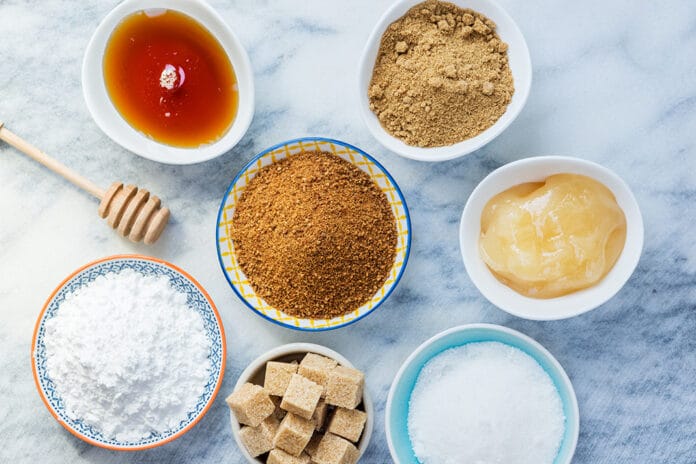The industrialized world loves its sugar, and no one disputes that. The usual suspects are cupcakes, candy, etc., but processed foods such as granola bars and canned goods have their fill of sugar. Sugar isn’t big news for the dental community; it promotes inflammation, weight gain, accelerated aging, and pesky dental decay. There is also an association between high sugar and periodontal disease.1,2
Dentistry 101 told us that sugars and other fermentable carbohydrates metabolize to acids by oral bacteria, which lowers oral pH and can initiate tooth demineralization. Refined sugars are empty calories, although, like all carbohydrates, they do provide energy to the body, brain, and nervous system.
Glucose is the simplest of carbs, a monosaccharide, meaning one sugar. Glucose regulation can be tricky, and maintaining proper levels is necessary for survival. For those that have insulin resistance, diabetes, or just want to lower their sugar intake, what should they do? There is an abundance of options, but how do those other sweeteners relate to oral health? Sugar alcohols, natural caloric sweeteners, natural zero-calorie sweeteners, modified sugars, and artificial sweeteners have different effects on our teeth and our bodies.
Sugar Alcohols
Fun fact. They aren’t a sugar or alcohol but are organic compounds and are classified as polyols. Common sugar alcohols are xylitol, erythritol, sorbitol, and maltitol. Some come from fruits and vegetables, but most are artificial. No dental caries are caused by this group. They have fewer calories, easier blood sugar management, fewer carbs, and are not absorbed or digested fully.
Xylitol, oh how we know about this one! A naturally occurring 5-carbon sugar in plants but does require refining for use as a sweetener.3 In dentistry, xylitol has been a beautiful addition in several ways, including the inhibition of Streptococcus mutans’ growth by disrupting their energy production processes and starving bacteria. When caries-causing bacteria such as S. mutans and Lactobacillus are forced to consume xylitol instead of glucose or fructose, they cannot make the enamel-attacking acids or sticky mucopolysaccharides that encourage adhesion to teeth.4
Likewise, xylitol increases salivary flow and pH by reducing both the numbers of cariogenic S. mutans and periodontopathic bacteria like Heliobacter pylori.5 Adults should work towards five to 10 grams a day in small doses. Perhaps one to two pieces of gum or two to four mints five times a day. Always as a caution, since too much can cause a laxative effect. This happens because the gut’s unabsorbed “sugars ” attract water that causes diarrhea.
Sorbitol, Mannitol, Maltitol, and Erythritol
Sorbitol is about half as sweet as sugar and is found naturally in some fruits like apples, apricots, and dates. Most are made from potato starch and are commercially manufactured from corn syrup to be used in prepackaged foods, beverages, and medications. It is often used in foods for people with diabetes.
If you compared sorbitol to xylitol for decay prevention, it may be less expensive, but it is also less effective. Cariogenic bacteria can still digest sorbitol ‒ however, very slowly. Because caries-causing bacteria can ferment sorbitol (feed on it), it should be considered a low-cariogenic sweetener rather than a non-cariogenic one (like xylitol is). The effects of sugar substitutes on caries rates have been evaluated not only in observational studies but in clinical trials. The results have shown sorbitol to decrease caries rates compared to controls.22
Mannitol is like sorbitol, but the difference has to do with a second carbon atom, a Fischer projection coming out of the plane or behind the plane. Feel free to investigate that further. Mannitol is used in medicine to decrease pressure in the eyes for glaucoma patients. Mannitol lingers in the intestines giving an unfortunate opportunity for bloating and diarrhea. Unlike sorbitol, mannitol doesn’t absorb into products, so you may see it as the dusting powder on chewing gum to help prevent the product from sticking to the wrapper. Similar to other sugar alcohols, mannitol is resistant to metabolism by oral bacteria.
Maltitol, yet another sugar alcohol, comes from corn syrup, is about 75% as sweet as sugar, and is used in gum, mouthwash, and toothpaste. Chewing maltitol-sweetened gum has been shown to lower several bacterial species. Maltitol is a glycemic sweetener and will raise blood sugar but not to the degree of table sugar, and glycemic levels are approximately half. Sadly, the “sugar-free” label can be misleading. One of the best qualities is that it tastes much closer to table sugar than other sugar alcohols but is still non-cariogenic.
How about erythritol, one of the go-to options for guided biofilm therapy? It doesn’t raise plasma glucose or insulin levels, is non-cariogenic, and is easy to digest. Ninety percent is absorbed in the small intestine, which helps prevent bloating and gastrointestinal upset.
However, much of the erythritol used in food and drinks is derived from cornstarch of genetically modified corn. Erythritol is sometimes combined with the artificial sweetener aspartame.
Several studies comparing the efficacy of sorbitol, xylitol, and erythritol show similar results. Long-term research demonstrated a slower rate of caries development and lower caries incidence in the erythritol group compared to sorbitol and xylitol, and no difference between xylitol and sorbitol.6 A human pilot study provided evidence that erythritol has favorable systemic effects on small vessel endothelial vasodilator function, hypertension, and central aortic stiffness in people with diabetes mellitus.7,8 Very similar to table sugar, a white crystal or powder can easily be sprinkled in coffee or on a grapefruit. While there aren’t official guidelines for the amount of erythritol we can handle, a rule of thumb is one gram for every 2.2 pounds. If you weigh 150 pounds, you could tolerate 68 grams which equal 13 teaspoons.
Note: Sugar alcohols should all be kept out of reach of dogs.
Natural Caloric Sweeteners
Kicking it old school with honey and maple syrup. Tasting delicious but can be harmful to teeth. Honey’s nutrition varies depending upon pasteurization. Unpasteurized honey is heated only slightly during processing which helps to retain the honey’s nutritional properties. The high heat in pasteurized honey is designed to prevent crystallization and fermentation but destroys sugar-tolerant yeasts and robs the honey of its nutritional value. It does keep it nice and smooth while extending its shelf life.
Raw honey is not the same as unpasteurized honey. It is kept in its natural state, with no heating or filtering, and contains natural bee pollen, royal jelly, beeswax, and propolis. Manuka honey and Ulmo honey have antiseptic properties and are antibacterial on cariogenic bacteria like S. mutans and Lactobacillus.9 While honey may be yummy, it’s high in fructose (38.2%) and glucose (31%), has a high glycemic index (GI), and can harm teeth.
My husband makes homemade granola, and the recipe includes a half cup of maple syrup. When I think about maple syrup, I have this Insta-worthy photograph in my mind of a family gathered around a huge maple tree, tap in place, galvanized bucket at the bottom catching all that “syrup” falling out of the tree. (I didn’t consider that it takes 43 gallons of sap to make one gallon of maple syrup and that farmers use a vacuum pressure tubing system.)
Pure maple syrup is 100% natural with no preservatives, artificial flavoring, or additives. So it must be a winner? Reality check. Maple syrup is basically all sucrose, and 1/3 cup is approximately 60 grams of sugar. Obviously, it can affect blood sugar levels, maybe not quite as much as table sugar, but it’s a lot. Though it has antioxidants, vitamins, and minerals and may be a healthy alternative to sugar, it will never replace an avocado.
Artificial Sweeteners
Saccharin, aspartame, and sucralose may not be linked to decay, and the effects are mixed. There have been associations with an increase in body weight, diabetes, cancer, and cardiovascular disease.10-12 Strong data has shown that they can cross the blood-brain barrier and disrupt hippocampal function, the seat of memory.13
Saccharin was first made in 1879, and we see it along with other artificial sweeteners inside toothpastes, mouthwashes, and lip balms. Artificial sweeteners trigger the taste receptors for sweetness on the tongue at a lower dosage, bringing a big appeal. There were “natural” toothpastes that were introduced in the 1970s, leaving out artificial ingredients to combat the beginning of the bad press following saccharin.
Aspartame can be as controversial as wearing white after Labor Day. Aspartame.org likes to mention on their site that “According to the American Dental Association, low-calorie sweeteners like aspartame don’t promote decay-causing acids in your mouth that can harm teeth.” They also note that clinical studies have shown that chewing sugarless gum for 20 minutes following meals can help prevent tooth decay.”14 Really? We have other options that may be more beneficial for our patients.
The most common sucralose-based product is Splenda. It comes in at 600 times sweeter than sugar. Of course, when comparing sucralose to sucrose, the non-cariogenic winner is sucralose.15 Makes sense, but something to consider is the bulking agents that are added. Agents such as maltodextrin and corn-based dextrose (aka sugar) allow them to pour and measure more like sugar and have cariogenic potential.16
A study in Diabetes Care found that if you consume sucralose, the risk of developing diabetes is profound. Daily consumption of diet soda was associated with a 36 percent greater risk of metabolic syndrome and a 67 percent greater risk of type 2 diabetes.17 For people with diabetes, it isn’t a terrific option. It was discovered that there was a 23% decrease in insulin sensitivity, which prevents glucose absorption in cells.
There is also a relationship between irritable bowel syndrome and Crohn’s disease. Sucralose has a more detrimental effect on gut bacteria than other artificial sweeteners.18
Natural Zero-calorie Sweeteners
Not all zero-calorie sweeteners are artificial. They happen to have no carbohydrates or calories and won’t spike blood sugar but may have an aftertaste. So far, they are considered harmless to teeth. Stevia, the most well-known, is made from the leaves of the plant Stevia rebaudiana. Stevia is added to sodas, energy drinks, condiments, cereals, and canned fruits. It has poor absorption, does not raise blood glucose, and has zero calories. The extracts are non-acidogenic and don’t support the growth of S. mutans and reduce biofilm accumulation.19
Monk fruit is a small green gourd whose juice is non-cariogenic with a glycemic index of zero, does not affect blood sugar, and is filled with antioxidants. It comes in several forms that include a sugar-like powder and liquid extract. Monk fruit is about 200 times sweeter than sugar but does taste a tad different. It has antibacterial effects found against not only S. mutans but Porphyromonas gingivalis and Candida albicans.20 Stevia and Monk fruit get two thumbs up from dental professionals.
Modified Sugars
These include high fructose corn syrup (HFCS), refiners’ syrup, caramel, inverted sugar, and golden syrup. HFCS is synthesized from corn and sold in two forms; one has 42% fructose, the other 55%, with glucose and water as the other components. Food manufacturers like HFCS because it is cheaper and easier to use than table sugar and is an alternative to sucrose.
HFCS can impact our gastrointestinal health, blood glucose control, and lipid metabolism.21 The sweetest form of HFCS has only 5% more fructose than sugar, and the most commonly used HFCS contains even less fructose than sugar. No matter what form, less is more. Classifying sugars as added or natural doesn’t tell the whole story.
Take the case of orange juice. A 16-ounce orange juice contains four oranges worth of sugar. If you had the whole fruit that contains fiber, it would fill you up, and the sugar from the fruit would be absorbed into the blood more slowly. During juice processing, the fiber is usually filtered out or pulverized. The juice’s dissolved sugar is efficiently absorbed by the small intestine and enters the blood quickly.
The real fruit may raise blood sugar but in a slower, more controlled manner. Metabolically speaking, juice is more like soda than it is whole fruit. While the sugars and acids found in some types of fruit can have a negative effect on tooth enamel, there’s no doubt that fruit offers a huge variety of health benefits that make it a far better option than other sugary or processed foods
Preventing tooth decay is a combination of bolstering the host environment, whether through salivary flow or probiotics, lessening the presence of bacteria, and reducing the food available for those bacteria. Those bacteria live for the sugar we eat ‒ literally. Thankfully, we have options that can be beneficial for our oral microbiome.
Before you leave, check out the Today’s RDH self-study CE courses. All courses are peer-reviewed and non-sponsored to focus solely on high-quality education. Click here now.
Listen to the Today’s RDH Dental Hygiene Podcast Below:
References
- Moreira, A.R.O., Batista, R.F.L., Ladeira, L.L.C., et al. Higher sugar intake is associated with periodontal disease in adolescents. Clin Oral Investig. 2021; 25(3): 983-991. doi:10.1007/s00784-020-03387-. https://pubmed.ncbi.nlm.nih.gov/32519237/
- Nyvad, B., Takahashi, N. Integrated hypothesis of dental caries and periodontal diseases. J Oral Microbiol. 2020; 12(1): 1710953. doi:10.1080/20002297.2019.1710953. https://www.ncbi.nlm.nih.gov/pmc/articles/PMC6968559/
- Islam, s.M., Munaim, R., Munaim, A. Sakinah, M. A perspective: Bioproduction of xylitol by enzyme technology and future prospects. International Food Research Journal. 2012; 19(2): 405-408. https://www.researchgate.net/publication/233987190
- Nayak, P.A., Nayak, U.A., Khandelwal, V. The effect of xylitol on dental caries and oral flora. Clin Cosmet Investig Dent. 2014; 6: 89-94. doi:10.2147/CCIDE.S5576. https://pubmed.ncbi.nlm.nih.gov/25422590/
- Nordblad, A., Suominen-Taipale, L., Murtomaa, H., et al. Smart Habit Xylitol campaign, a new approach in oral health promotion. Community Dent Health. 1995; 12(4): 230-234. https://pubmed.ncbi.nlm.nih.gov/8536087/
- Runnel, R., Mäkinen, K.K., Honkala, S., et al. Effect of three-year consumption of erythritol, xylitol and sorbitol candies on various plaque and salivary caries-related variables. J Dent. 2013; 41(12): 1236-1244. doi:10.1016/j.jdent.2013.09.007. https://pubmed.ncbi.nlm.nih.gov/24095985/
- Flint, N., Hamburg, N.M., Holbrook, M., et al. Effects of erythritol on endothelial function in patients with type 2 diabetes mellitus: a pilot study. Acta Diabetol. 2014; 51(3): 513-516. doi:10.1007/s00592-013-0534-2. https://pubmed.ncbi.nlm.nih.gov/24366423/
- de Cock, P. Erythritol Functional Roles in Oral-Systemic Health. Adv Dent Res. 2018; 29(1): 104-109. doi:10.1177/0022034517736499. https://pubmed.ncbi.nlm.nih.gov/29355425/
- Ahmadi-Motamayel, F., Hendi, S.S., et al. Antibacterial activity of honey on cariogenic bacteria. J Dent (Tehran). 2013; 10(1): 10-15. https://www.ncbi.nlm.nih.gov/pmc/articles/PMC3666059/
- Suez, J., Korem, T., Zeevi, D., et al. Artificial sweeteners induce glucose intolerance by altering the gut microbiota. Nature. 2014; 514(7521): 181-186. doi:10.1038/nature13793. https://pubmed.ncbi.nlm.nih.gov/25231862/
- Nettleton, J.E., Reimer, R.A., Shearer, J. Reshaping the gut microbiota: Impact of low calorie sweeteners and the link to insulin resistance? Physiol Behav. 2016; 164(Pt B): 488-493. doi:10.1016/j.physbeh.2016.04.029. https://pubmed.ncbi.nlm.nih.gov/27090230/
- Pearlman, M., Obert, J., Casey, L. The Association Between Artificial Sweeteners and Obesity. Curr Gastroenterol Rep. 2017; 19(12): 64. doi:10.1007/s11894-017-0602-9. https://pubmed.ncbi.nlm.nih.gov/29159583
- Davidson, T.L., Chan, K., Jarrard, L.E., et al. Contributions of the hippocampus and medial prefrontal cortex to energy and body weight regulation. Hippocampus. 2009; 19(3): 235-252. doi:10.1002/hipo.20499. https://pubmed.ncbi.nlm.nih.gov/18831000/
- Benefits of Aspartame (n.d.). Calorie Control Council: Aspartame. https://aspartame.org/benefits-of-aspartame/
- Bowen, W.H., Young, D.A., Pearson, S.K. The effects of sucralose on coronal and root-surface caries. J Dent Res. 1990; 69(8): 1485-1487. doi:10.1177/0022034590069008070. https://pubmed.ncbi.nlm.nih.gov/2384624/
- Mandel, I.D., Grotz, V.L. Dental considerations in sucralose use. J Clin Dent. 2002; 13(3): 116-118. https://pubmed.ncbi.nlm.nih.gov/11887514/
- Nettleton, J.A., Lutsey, P.L., Wang, Y., et al. Diet soda intake and risk of incident metabolic syndrome and type 2 diabetes in the multi-Ethnic Study of Atherosclerosis (MESA). Diabetes Care. 2009; 32(4): 688-694. doi:10.2337/dc08-1799. https://pubmed.ncbi.nlm.nih.gov/19151203/
- Pepino, M.Y., Tiemann, C.D., Patterson, B.W., et al. Sucralose affects glycemic and hormonal responses to an oral glucose load. Diabetes Care. 2013; 36(9): 2530-2535. doi:10.2337/dc12-222. https://pubmed.ncbi.nlm.nih.gov/23633524/
- Brambilla, E., Cagetti, M.G., Ionescu, A., et al. An in vitro and in vivo comparison of the effect of Stevia rebaudiana extracts on different caries-related variables: a randomized controlled trial pilot study. Caries Res. 2014; 48(1): 19-23. doi:10.1159/000351650. https://pubmed.ncbi.nlm.nih.gov/24216624/
- Zheng, Y., Liu, Z., Ebersole, J., Huang, C.B. A New Antibacterial Compound from Luo Han Kuo Fruit Extract (Siraitia grosvenori). J Asian Nat Prod Res. 2009; 11(8): 761-765. doi:10.1080/10286020903048983. https://pubmed.ncbi.nlm.nih.gov/20183321/
- Herman, M.A., Samuel, V.T. The Sweet Path to Metabolic Demise: Fructose and Lipid Synthesis. Trends Endocrinol Metab. 2016; 27(10):719-730. doi:10.1016/j.tem.2016.06.005. https://www.ncbi.nlm.nih.gov/pmc/articles/PMC5035631/
- Hayes, C. The Effect of Non-cariogenic Sweeteners on the Prevention of Dental Caries: A Review of the Evidence. J Dent Educ. 2001; 65(10): 1106-1109. https://pubmed.ncbi.nlm.nih.gov/11699985












